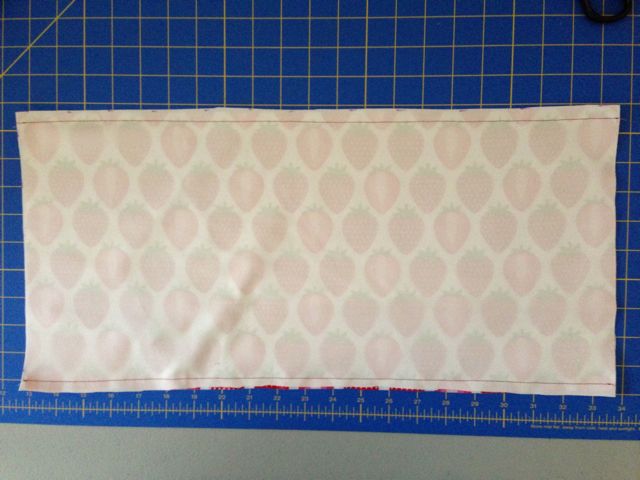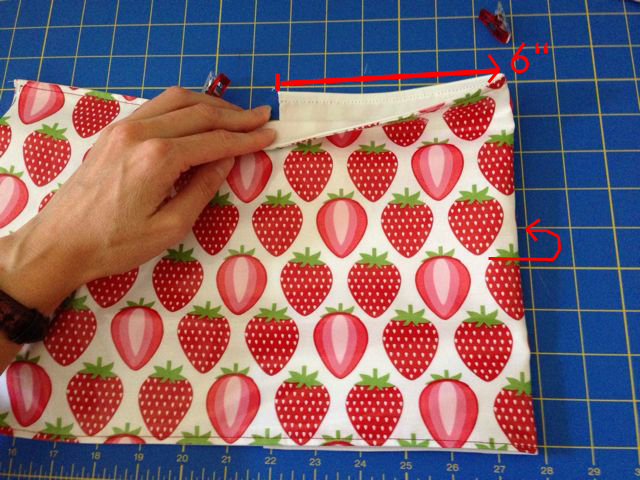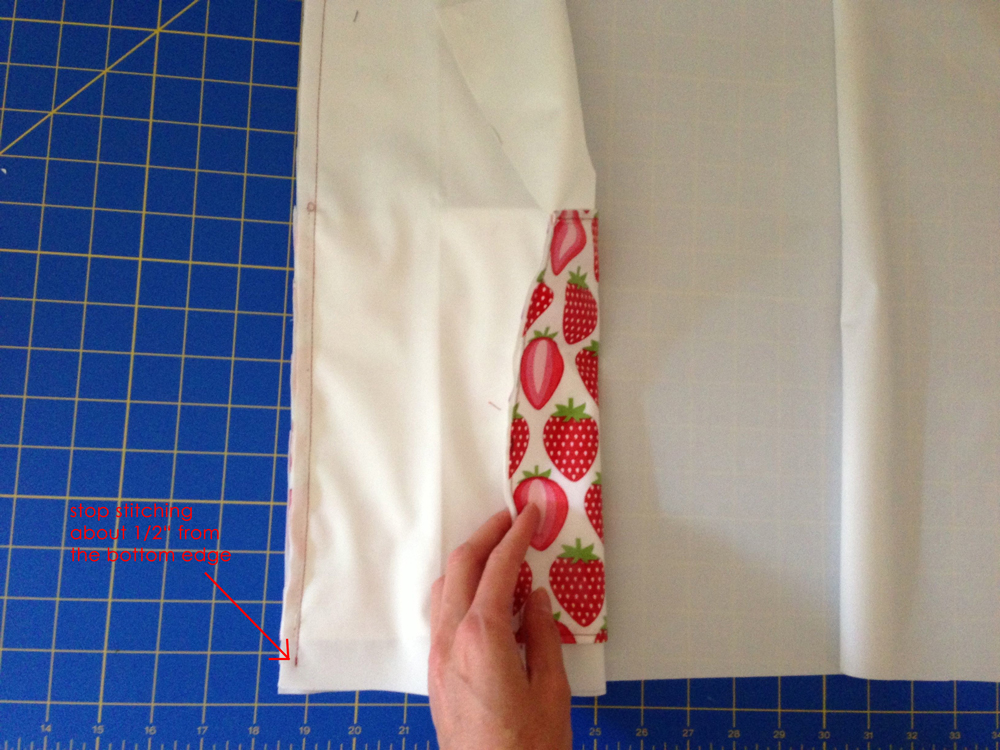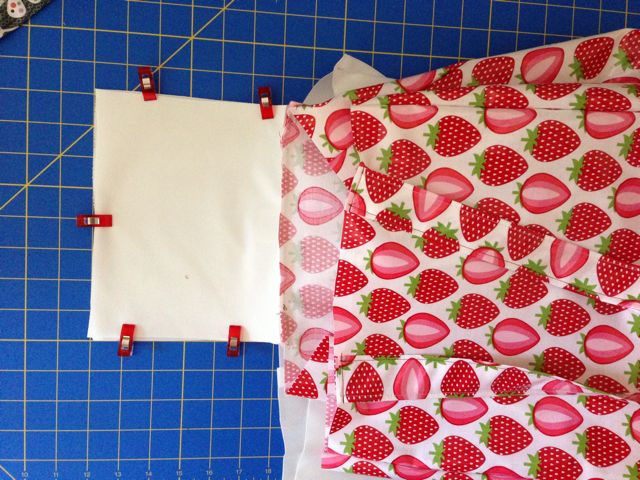September is National Sewing Month and today I wanted to post this fun tutorial which I contributed to the Favecrafts Blog of AllFreeSewing last year as a guest poster! I am still using this tote when I go grocery shopping and like it a lot, especially the happy strawberry print! I never posted this on my website so I thought this is the perfect time to do it. So here we go, please find the original post below. And while your at it, do go check out all the awesome posts on Seams and Scissors for National Sewing Month this year (that's the new blog of AllFreeSewing). Hint: I will have a free bag making tutorial coming up there very soon!!
This bag is great for laminated cotton or oilcloth, but you could also use home decor fabric or just simply lightweight quilting fabric. If you do, I recommend interfacing the exterior fabric pieces as stated below in the instructions.
All seam allowances are ½” unless otherwise stated. All measurements given are height x width. Please read all instructions before you begin.
You need:
- Exterior fabric: 1 1/8 yd (44" width)
- Lining fabric: 1 yd (44" width)
- 1 piece of hook and loop tape (self-adhesive or sew-on): 1”
Helpful hints:
- I made this tote completely out of laminated cotton. If you decide to do so too, please be careful when ironing parts of your fabric while sewing. I usually place a kitchen towel on top of the fabric, which is folded twice. I like to sprinkle the towel a little bit with water and used less steam than usual. I also don't use the highest setting of the iron and I don't press too long at the same spot.
- I also recommend using sewing clips instead of pins as they won’t leave holes in your laminated cotton or oilcloth.
Cut from:
Exterior fabric:
- (2x) 16" x 12.75” – main body
- (2x) 16" x 9” – side panel
- (1x) 9" x 12.75” – bottom panel
- (1x) 10" x 21” – interior divider
- (2x) 29" x 5.5” – strap
Lining fabric:
- (2x) 16" x 12.75” – main body
- (2x) 16" x 9” – side panel
- (1x) 9" x 12.75” – bottom panel
- (1x) 10" x 21” – interior divider
- (2x) 8" x 9” – slip pocket
I didn’t use any interfacing on this tote since I used laminated cotton throughout and intended a slouchy look. If you use lightweight cotton fabric you might want to interface parts of your tote. In this case, cut the following pieces from fusible interfacing:
- (2x) 16" x 12.75” – main body
- (2x) 16" x 9” – side panel
- (1x) 9" x 12.75” – bottom panel
If you don't need to fold your tote when not using it, you may also think about interfacing the interior divider with heavy stabilizer. In this case cut the following piece from heavy stabilizer:
- (1x) 10" x 21” - interior divider
Interface the wrong sides of the exterior parts of your tote.
Instructions
a) Make the straps
- Fold one of your strap fabric pieces in half lengthwise, with the wrong sides together and press. Open up again and fold both long edges towards the middle crease and press again.
- Place one of the straps onto one of the exterior main body panels. The outer edges of the strap should be placed 2.5” in from the side edges of the bag. The loop of the strap should face to the bottom and the raw edges of both main body panel and straps should be aligned. Pin in place and baste the strap end to the main body using a ¼” seam allowance.
- Repeat for the other strap and the other main body panel.
- Place the hook part of your piece of hook and loop tape onto the right side of one of the slip pocket pieces. It should be positioned centered and 1” down from the top edge. Tape it down or sew it onto the fabric (depending on what kind of hook and loop tape you are using).
- Repeat with the loop part of the hook and loop tape and the other slip pocket piece.
- Pin in place and stitch along the top edge using a 1/4” seam allowance, starting and stopping 1/2” from the outer edges of the slip pocket fabric piece.
- Repeat the previous step with the second slip pocket fabric piece and one of the lining main body panels.
- Set both main body panels aside.
- Take both of your interior divider pieces and put them right sides together. Pin in place and stitch along both long edges.
- Repeat the 6” markings, folding and topstitching on the other side of the divider.
- Repeat the previous step with the other slip pocket piece on the exterior main body panel.
Take one of the lining main body panels and place it right side up. Take one of your lining side panels and put it on one of the side edges of the main body panel, right sides together, the edges of both pieces should be aligned. Pin in place and stitch along the edge, but stop 1/2" up from the bottom end (this 1/2" is important later, when you are going to sew the bottom panel onto the bag).
- Repeat with the second side panel and the other edge of the main panel (when stitching the side panel with the divider attached, make sure to fold the divider together so it won't get caught in the stitching).
- Take your second main panel and repeat the previous steps.
- Repeat step d) to assemble the bag exterior.
- Place your two slip pocket fabric pieces right sides together (since they are already attached to the exterior and lining main body you will have to bend those parts out of the way for this step). Pin in place and stitch around the three edges of the slip pocket. Make sure to start and stop the stitching right beneath the topstitching of the top edge of the slip pocket pieces.
- Due to the finished slip pocket, the bag exterior and the bag lining are already attached to each other. The bag exterior should be right side out, the bag lining wrong side out. Put the bag lining into the exterior. The slip pocket will be hidden between the layers. Make sure to fit the lining correctly into the exterior. Match the side seams and flatten the bottom panels, so that the lining sits snug inside the bag.
- Fold down the seam allowance of the top edges of both exterior and lining towards the inside. Pin in place and stitch along the top edge using a 1/4” seam allowance. Start and stop right before you reach the slip pocket.



























 RSS Feed
RSS Feed





